 |
| silk tatted lace edging for my wedding dress |
If you asked me as a young girl what I wanted to do when I grew up, I wouldn't have had some answer that suggested I wanted to labor away for some corporation eight hours every weekday. I had no visions of being a Redcross nurse and patching up soldiers (unless it was for the other side), or of being some schoolteacher (I'd have encouraged all the students to play hooky), or of being the secretary to the President of the United States (nor of being the president).
No, I'd have told you that I would much prefer to make leather shoes and spin yarn for sweaters for my babies... and tat lace. Even now, I can't imagine a better aspiration than to sit in a rocker of luxurious wood on embroidered cushions and tat yards of silk lace with my silver shuttle.
We all have a grandmother, or a friend who has a grandmother, who made lace. Depending on their heritage and background, they may have done tape lace, bobbin lace, or needle lace among many others. My grandmother (and great-great-great-grandmother) tatted, and although I knew neither very well (one due to distance the other to death) I did not learn to tat lace at a young age.
 |
| Bookmark tatted by my great, great, great grandmother |
Lace tatting emerged sometime in the late18th or 19th century, a sort of "new parlor trick" reminiscing the Egyptian and Chinese knotted laces. For a hot moment it was the fad and feathery patterns featured in all the women's magazines.
One would use a small hand shuttle made of silver, a cheap metal, or bone with a machine bobbin filled of thread squeezed inside. These days you can buy all sorts of different shuttles from wood to porcelain to an assortment of metals. The lace is formed with both hands from precise movements and combinations of loose and taut tension.... really, it's a series of knots on an adjustable loop. Tatting can also be done with a needle as long as the eye isn't large than the rest of the needle and can be done with crocheting to create dimensional lace.
Tatted lace was mostly used for Royal garnishes, babies' gowns, and women's and men's collars and cuffs, bookmarks. While it is mostly an artifact of historical women's pastimes, tatted lace trim is still most commonly used to edge traditional Catholic priests' collars. I find the fact that lace in general was mostly for men and babies to be a fascinating factoid, and that women would make lace for their men or priests or babies, while chatting therefore also knotting their community together. Interestingly enough, tatting is called chiacchierino in Italian, which means chatting.
I found my first tatting shuttle, a cheap, but vintage metal, in an old box of lace trims, some of which were tatted. I saved it for when I might go see my grandmother next. It was then that she gave me the bookmark made by my great-great-great grandmother Mary Ann Wheeler. I know little about my times-three grandmother except that she was half Osage, born Mary Ann West on December 2nd, 1868, and passed in 1949. This bookmark is a most cherished possession... I've managed to lose it many times, and always find it again. As if it belongs with me somehow!
My grandmother, Gloria, was born three years after Mary Wheeler passed. But she found a small green book and taught herself to tat, mostly doing edgings that she attached to various garments and towels and gave away as gifts. I did not grow up around this side of the family, but my mom would tell me how her mother could make lace. After finding the old box of tatting supplies, I drove cross country to visit my grandmother Gloria and learned to tat. It had been a while since my grandmother had tatted, and so I supplemented my education with YouTube.
It took much of the next couple days to figure out how to make a single ring of lace, and how to connect them. The tension is odd at first... it requires a sort of dance between the fingers in which they are always poised at loose but exacting angles to adjust the tension with the minimal movement. After making quite a bit of the purple and yellow lace and perfecting the basic lace structure, I moved onto other things.
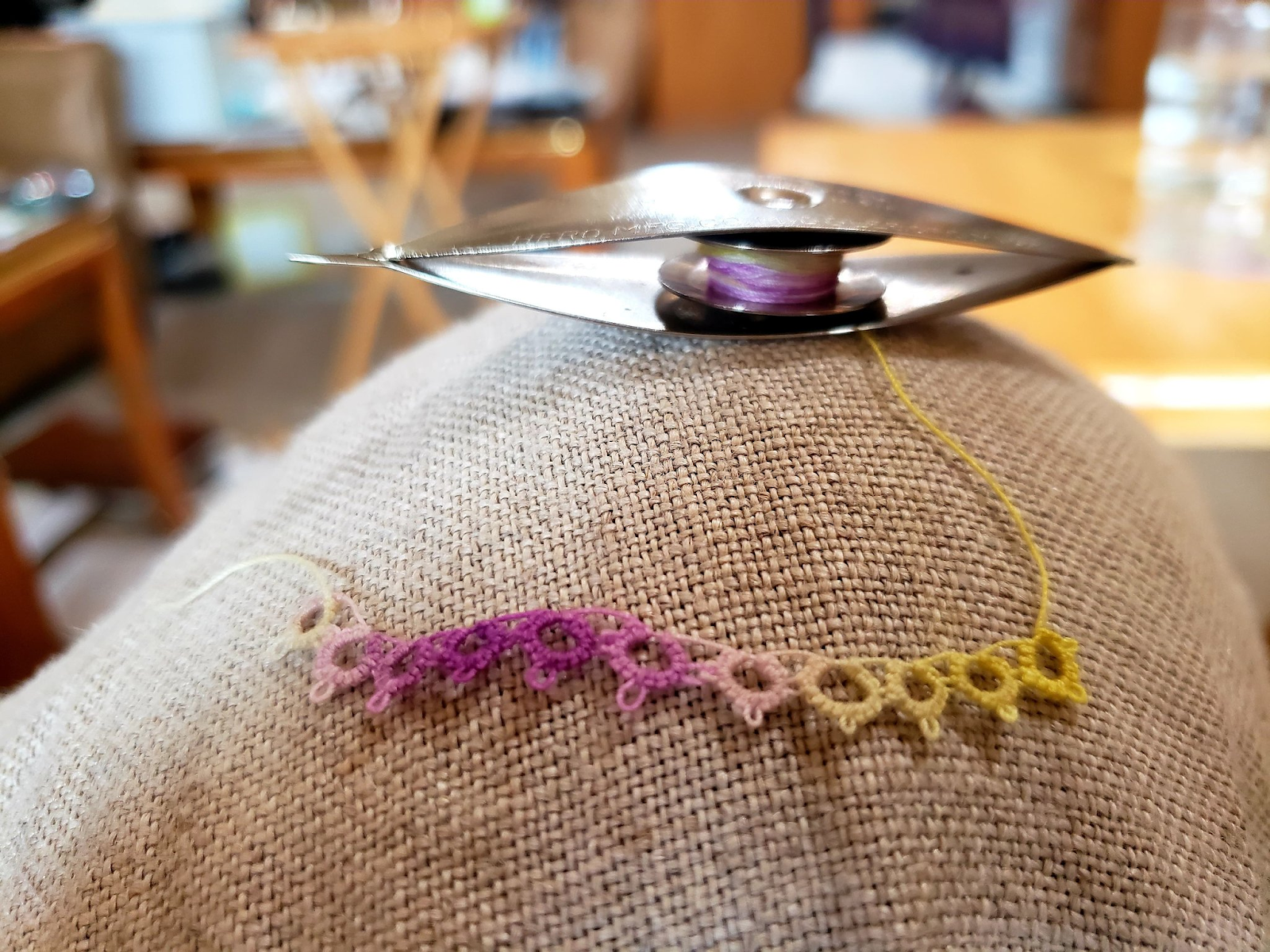 |
| my first string of lace |
 |
| my first lace ring |
My next challenge was tatting a small doily, for a porcupine I joked, just to see what I could do freehand with my shuttle. I made a cute little piece of lace that I had no idea what to do with, until nearly a year later... when I decided to slip it into the first letter I sent to the man who would become my fiancé.
And then I began a masterpiece: twenty-five feet of lace edging for a quilt I'd been working on. The most wonderful thing about doing such a large project is how many connections it brought: little children came to ask, "can you show me how?" and old women drew closer "are you tatting!?" Even men were amazed and wanted to "touch this magical thing."
It took about six months to make enough lace for the quilt. Lace patterns, although intricate, are repetitive, and so after doing about eight inches I had the pattern pretty well memorized, and it became a lovely, mindless activity to do whenever I might be sitting down.
I am now working on about twenty yards of silk tatted lace (hoping to do most of it with a silver shuttle I found on eBay) for my wedding dress. I'm currently about four yards in and enjoying the rhythm and of having something so pretty in my hands whenever I feel tired and useless. After that I don't plan on doing anymore major laces: I would love to do some barefoot style shoes, make small trims for towels and pillowcases and baby clothes, and make see if my husband will let me attach a King James' style collar to his jacket... I just love the idea of embellishing my family's arrayment, as much as it is polite and tasteful to do so.
If you're curious to see more modern tatted lace, check out this Instagram woman that sells tatted earrings Wendy Carballo (@wendy_the_lacemaker) • Instagram photos and videos
 |
| needle tatting made by an older woman in Iowa |
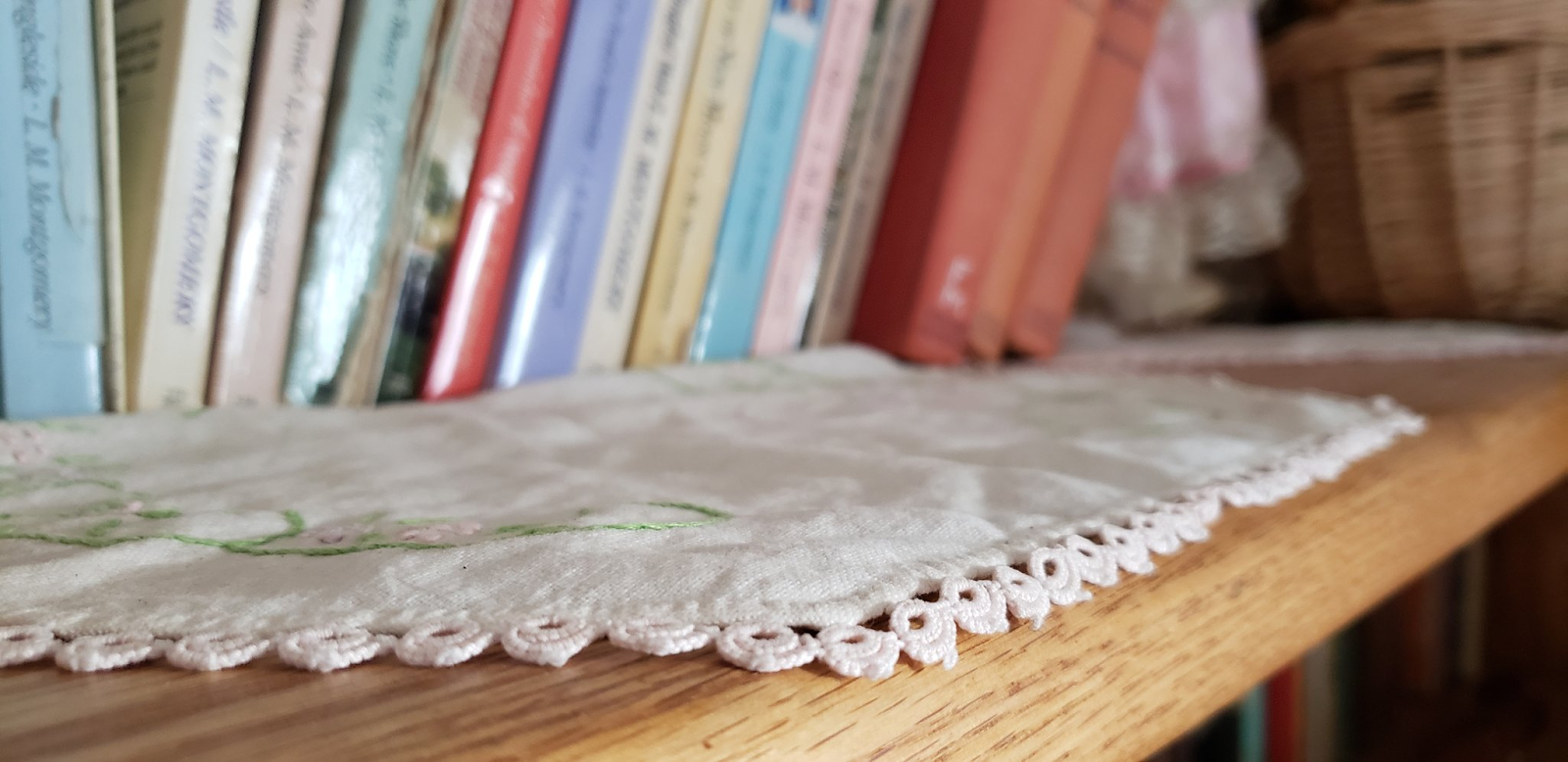 |
| vintage tatted lace |
.
Because we are slowly losing the ways of our grandmothers, I feel it is partly my duty to spread the skills I've learned, and I've taught as many others to tat as would like to learn. I hosted my first tatting class June 2022 when hosting the Yellowstone Outpost Porcfest. I've since offered classes through my Livingroom Academy program, but mostly just teach people spontaneously whenever they see me tatting and ask to be shown.

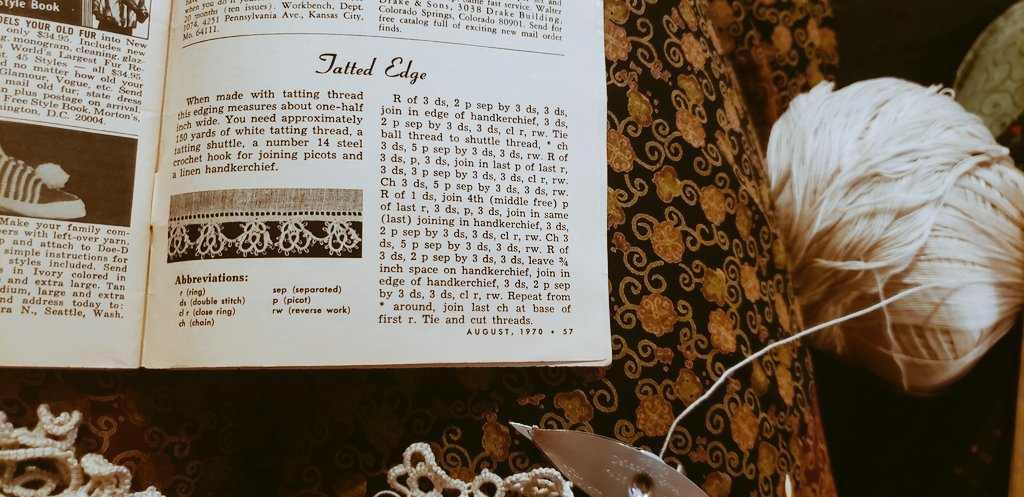





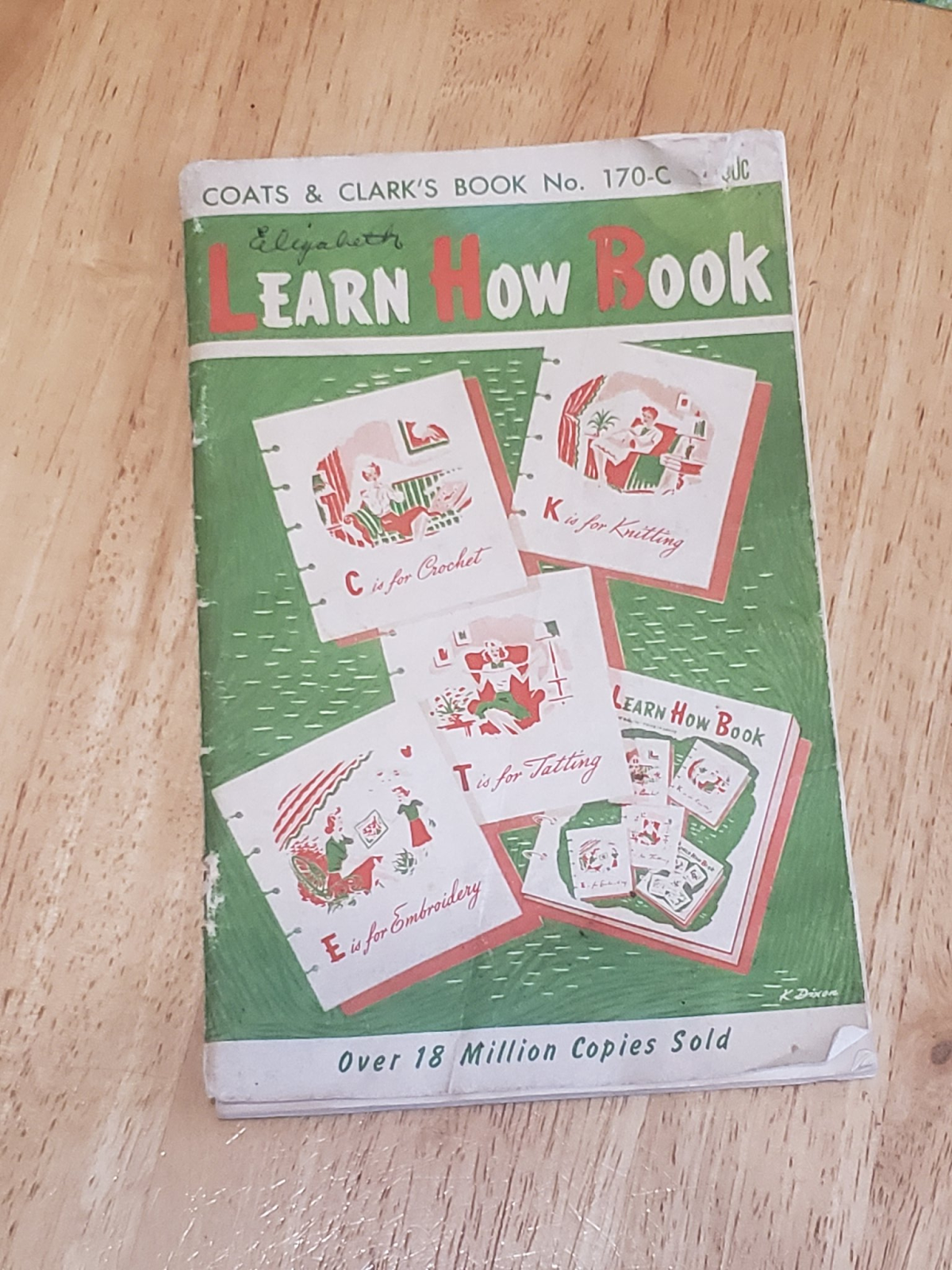






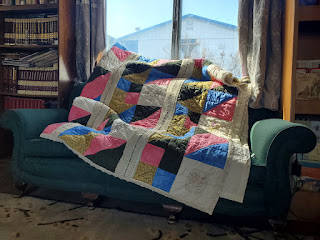



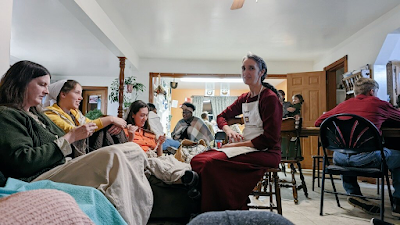
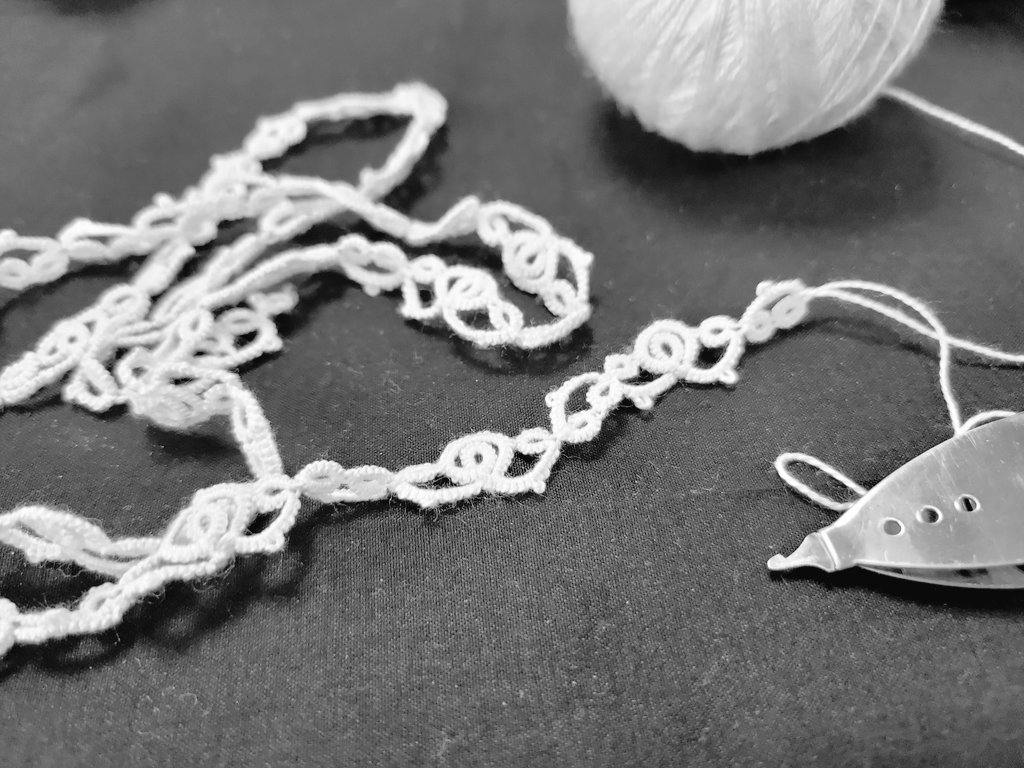
This is so cool, Keturah! Until I saw some of your previous posts about tatting lace for your quilt, I hadn't realized that it was something one could do without specialized equipment (beyond a shuttle). Which is really cool!
ReplyDelete"it salves the common ADHD tick bubbling in most women's hands". Okay, I'm glad I'm not the only one who experiences this! Because I constantly want something to do with my hands, and it helps me pay better attention, most of the time! My solution to that is knitting. I knit in my college classes CONSTANTLY, and a lot of other times, too. My current project is a pair of fingerless gloves for one of our priests, but I'm also slowly but surely finishing a cardigan for myself. I wonder if it has to do with how our brains are wired, as women. Because it could be interpreted as "women feel guilty for not doing something, even when they're sitting still", but I like the interpretation of "we need something to do with our hands, because they get itchy and want to be doing something" much better.
Yes, I used to knit a lot, too!! I really do think it is a natural way to being a woman.. and it has such lovely results, too, for the people and priests we know!!! I hope you get to try out tatting... you can easily find shuttles on etsy and it's sooo fun to learn!
Delete